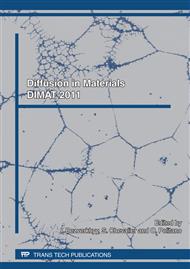[1]
Y. Yamamoto, H. Miyanaga, T. Amazawa, T. Sakai: IEEE Transactions On Electron Devices. Vol 32 (1985), p.1231.
Google Scholar
[2]
S.S. Simeonov, E.I. Kafedjiiska, A.L. Guerassimov: Thin Solid Films. Vol 115 (1984), p.291.
DOI: 10.1016/0040-6090(84)90092-0
Google Scholar
[3]
G. Kano, S. Takayanagi: IEEE Transactions On Electron Devices. Vol 14 (1967), p.822.
Google Scholar
[4]
V.Q. Ho: J Electronic Matl. Vol 16 (1987), p.329.
Google Scholar
[5]
M. Yamana, M. Lamantia, V. Philipsen, S. Wada, T. Nagatomo, Y. Tonooka: Proceedings of SPIE. (2009), p.7379.
Google Scholar
[6]
E. Schubert, F. Frost, B. Ziberi, G. Wagner, H. Neumann, B. Rauschenbach: J Vac Sc & Tech: Microelectronics and Nanometer Structures. Vol 23 (2005), p.959.
DOI: 10.1116/1.1924610
Google Scholar
[7]
H. Takenaka, H. Ito, T. Haga, T. Kawamura: J Synchrotron Rad. Vol 5 (1998), p.708.
Google Scholar
[8]
I. Nedelcu, R.W.E. van de Kruijs, A.E. Yakshin, F. Bijkerk: J Appl Phy. Vol 103 (2008), p.083549.
DOI: 10.1063/1.2907964
Google Scholar
[9]
E. Heikinheimo, A. Kodentsov, J. A. Van Beek, J. T. Klomp and F. J. J. Van Loo: Acta Metall Mater. Vol 40 (1992), p.111.
DOI: 10.1016/0956-7151(92)90270-o
Google Scholar
[10]
J.J. Petrovic, R.E. Honnell, W.S. Gibbs: US patent 4970179.
Google Scholar
[11]
M.G. Mendiratta, D.M. Dimiduk: Mater Res Soc Symp Proc. Vol 133 (1989), p.441.
Google Scholar
[12]
M.G. Mendiratta, D.M. Dimiduk: Scripta Metall. Vol 25 (1991), p.237.
Google Scholar
[13]
P.R. Subramanian, T.A. Parthasarathy, M.G. Mendiratta, D.M. Dimiduk: Scripta Metall. Vol 32 (1995), p.1227.
Google Scholar
[14]
M.R. Jackson, B.P. Bewlay, R.G. Rowe, D.W. Skelly, H.A. Lipsitt: JOM. Vol 48 (1996), p.39.
DOI: 10.1007/bf03221361
Google Scholar
[15]
B.P. Bewlay, M.R. Jackson, P.R. Subramanian, J.C. Zhao: Metall Mater Trans A. Vol 34A (2003), p. (2043).
Google Scholar
[16]
S. Prasad, A. Paul: Acta Materialia. Vol 59 (2011), p.1577.
Google Scholar
[17]
S. Prasad and A. Paul: Intermetallics. Vol 19 (2011), p.1191.
Google Scholar
[18]
S. Prasad and A. Paul, Journal of Phase Equilibria and Diffusion, Vol. 32 (2011), p.212.
Google Scholar
[19]
M. Salamon, A. Strohm, T. Voss, P. Laitinen, I. Riihimäki, S. Divinski, W. Frank, J. Räisänen, H. Mehrer: Phil Mag. Vol 84 (2004), p.737.
DOI: 10.1080/14786430310001641966
Google Scholar


